The Most Talkative Bird Species: Understanding Avian Communication
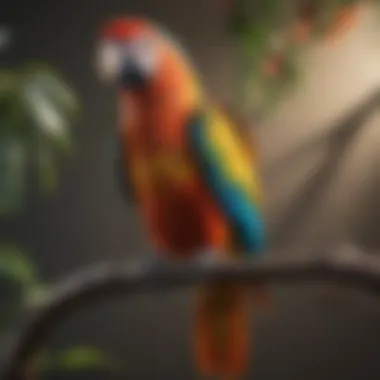
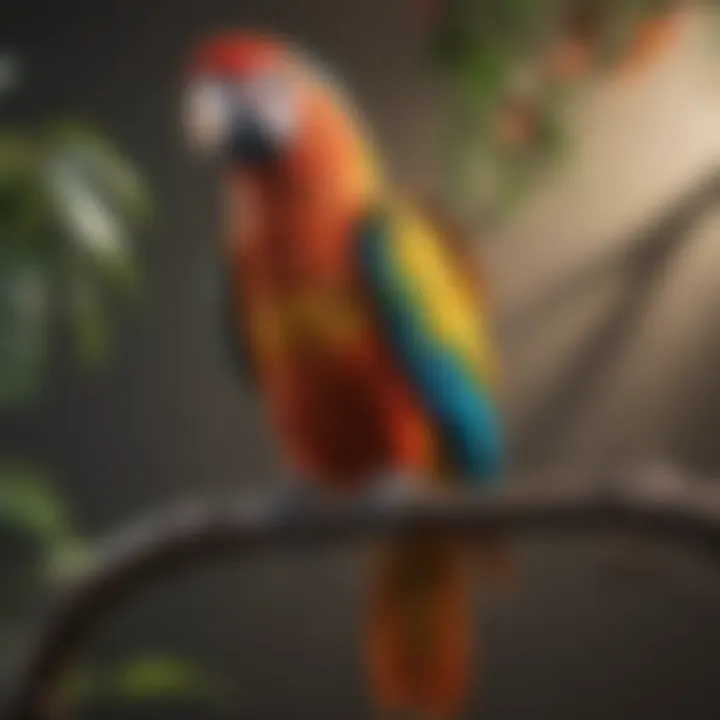
Intro
Understanding the intricate world of avian communication is paramount for pet bird owners and enthusiasts. Birds, especially certain species, exhibit remarkable vocal abilities, reaching a level of interaction that can mirror human speech. This article will explore several aspects of this fascinating subject, including the most talkative bird species, effective care methods, and essential training techniques.
Investing in a talkative pet bird can provide immense joy and delight. However, this venture also brings forth a set of responsibilities. It is crucial to approach bird ownership with an informed mindset. This means not only providing proper care and a healthy environment but also engaging in meaningful interactions that foster vocal development.
In the upcoming sections, you will find detailed insights about daily routines, cage setup, nutrition, behavioral insights, and enriching activities. The aim is to present you with comprehensive knowledge to optimize your experience with a talkative bird while enhancing its vocal skills.
Preface to Avian Communication
Understanding avian communication is a complex yet fascinating subject. Birds, especially those kept as pets, communicate in various ways. Sounds like chirps, whistles, and calls are just the tip of the iceberg. The study of how birds vocalize provides insights into their emotional states, social interactions, and even cognitive abilities.
In this article, we will explore why certain species are more vocal than others and the underlying biology that contributes to their communication skills. Owners of birds, from novices to seasoned breeders, will benefit from understanding these nuances. Knowing how to interpret bird calls can enhance the bond between the owner and the bird, leading to more meaningful interactions.
Additionally, exploring avian communication illuminates the care and training techniques best suited for creating a stimulating environment. Birds can be expressive creatures, and recognizing their needs is key for responsible ownership. By understanding the basic principles of avian communication, one can foster a better home for these chatty companions.
The Nature of Bird Vocalization
Bird vocalization serves multiple purposes. For many species, these sounds are crucial for attracting mates, establishing territory, or signaling alarm. Birds are capable of producing a wide array of sounds that can convey different meanings. Vocalization also plays a significant role in the social hierarchy among birds. For instance, in flocks, certain calls may indicate the presence of food or warn others of predators. The ability of birds to adapt their vocalizations based on the situation demonstrates their intelligence and flexibility.
Moreover, pet birds are known for mimicking human speech and sounds. Some species, like the African Grey Parrot, exhibit extraordinary aptitude in this regard. They can reproduce not just words, but tones and inflections, making interactions with them unique.
The critical factors that influence vocalization include genetics, environmental stimulation, and social interactions. Knowing these aspects can lead to better care for your pet bird.
Comparison to Other Animal Communication
Birds share vocal communication traits with other animals, but they are unique in their ability to mimic a wide variety of sounds. For example, dogs communicate primarily through barking, growling, or whining, which convey a more limited range of emotions or needs. In contrast, birds can mimic human speech and various environmental sounds, showing their adaptability in communication.
Studies have shown that many mammals and some reptiles also possess intricate communication methods. However, few animals can imitate the range of sounds that birds, especially parrots, can replicate. While the complexity of animal communication varies widely, birds occupy a distinctive niche in their vocal flexibility.
Understanding these differences helps in recognizing what makes avian communication special. It also highlights the intelligence inherent in talkative bird species. Each bird possesses its own means for expressing needs and emotions, creating a rich tapestry of communication that is fascinating to explore.
"Birds possess a vocal flexibility that often surpasses that of many other animal species, making their communication both varied and intricate."
In summary, the study of avian communication not only deepens our understanding of these remarkable creatures but also enhances our ability to care for and connect with them. Recognizing the specifics of how birds communicate will lead to more satisfying experiences for both the pet and its owner.
Top Species of Talkative Pet Birds
The realm of pet birds offers a unique perspective into avian communication. Understanding the species that excel in vocalization is essential for pet owners who seek companionship and interaction. Talkative birds not only provide joy but also stimulate engagement between human and animal. Recognizing which birds have the potential for speech can guide prospective owners towards informed choices.
When examining the top species of talkative pet birds, several factors come into play. These include vocalization skills, social behavior, and adaptability to training. Birds that possess advanced vocal abilities often display complex behaviors that can enrich their interactions with their owners. Here, we will explore five notable species, highlighting their distinctive traits and the implications for potential bird parents.
African Grey Parrot
The African Grey Parrot is widely regarded as one of the most intelligent and linguistically adept bird species. Their ability to mimic not just sounds but also emotions has captivated many bird enthusiasts. African Greys can produce a wide array of words and phrases, often using them in context. This reflects a higher level of understanding than mere mimicry.
In terms of temperament, these parrots require social interaction and mental stimulation. Without proper engagement, they can develop behavioral issues. Owners must be prepared to invest time in training and social rules. Otherwise, the potential for their talkative nature may not be fully realized.
Amazon Parrots
Amazon Parrots are known for their vibrant personalities and exceptional vocal skills. These birds often develop a substantial vocabulary, making them delightful companions. They tend to have distinct vocal patterns which can mimic songs, television shows, and even phone ring tones.
A salient aspect of Amazon Parrots is their need for strong social bonds. They thrive in environments where they can engage with their owners frequently. A well-socialized Amazon can become a sealed source of amusement, capable of retaining a range of phrases learned during interactions.
Budgerigars
Budgerigars, commonly termed as budgies, are not only popular for their playfulness, but they also have a remarkable talent for speech. Though they are smaller in size compared to other talking birds, many budgies can learn to say several words and phrases. Their ability to mimic human sounds varies among individuals.
Budgies are often characterized by their large social needs and need for companionship. Regular interaction is crucial for developing their vocal skills. They can learn from each other, making for an engaging atmosphere if owned in pairs. Owners should be prepared to facilitate opportunities for vocal interaction to nurture their learning potential.
Cockatoos
Cockatoos are among the most affectionate birds often capturing the heart of their owners with their playful antics. Known for their loud calls and ability to mimic sounds, these birds can also develop a sizable vocabulary. Many Cockatoos will speak words and phrases enthusiastically when interacting with their human companions.
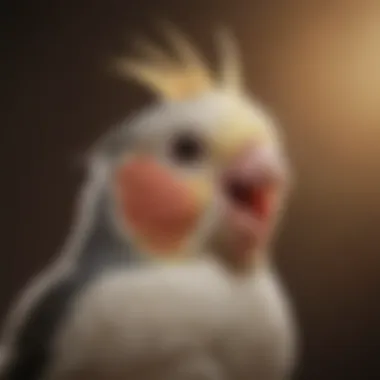
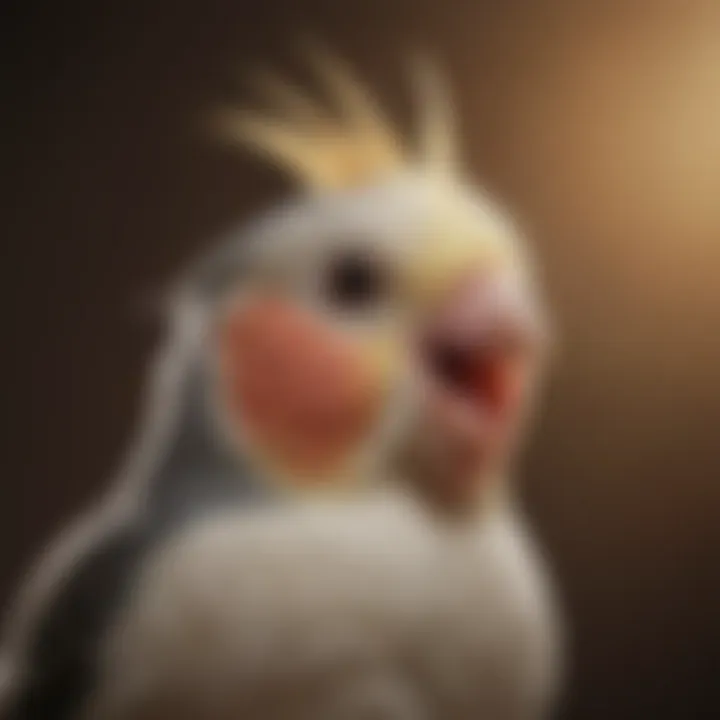
Although they are capable of speech, they also require substantial social interaction and mental stimulation. Cockatoos are sensitive and emotional birds. Failure to provide adequate attention can lead to stress, ultimately affecting their vocal abilities. Thus, understanding their emotional needs is crucial for potential owners.
Macaws
Macaws are impressively large birds known for their beauty and exuberance. Their vocalization skills are quite developed, and they can learn numerous words and phrases throughout their lives. Their colorful personalities and engaging nature make them appealing pets for many.
However, macaws demand a high level of commitment in terms of training and interaction. They are social creatures that flourish in lively environments. Offering them a stimulating atmosphere not only encourages vocal skills but also helps in mitigating behavioral issues. Thorough knowledge of their needs is essential before considering adopting a macaw.
In summary, understanding the top species of talkative pet birds equips potential bird owners with the necessary insight for responsible ownership. Each species has unique requirements and capabilities that can enhance the human-animal bond. As we explore further aspects of avian communication, these traits will provide a foundation for effective training and interaction.
Factors Influencing Avian Speech
Understanding the factors that influence avian speech is essential for anyone interested in fostering vocal abilities in pet birds. Several elements play a critical role in a bird’s capacity and inclination to mimic sounds, including genetic factors, social interactions, and environmental enrichment. By gaining insight into these aspects, bird owners can tailor their approach to maximize the communicative potential of their feathered companions.
Genetic Predisposition
Genetic predisposition significantly impacts a bird’s ability to talk. Some species, such as the African Grey Parrot, naturally possess a higher vocal capacity than others. This innate talent stems from their evolutionary background, as these birds have developed complex vocalizations in the wild for social interaction.
Not every bird will have the same level of aptitude for speech. Some might be genetically inclined to mimic human sounds with ease, while others may struggle to produce clear vocalizations. For instance, Amazon parrots are known for their impressive mimicry skills, while other species may not have such strong genetic traits.
Observing individual differences within a species is important. Each bird can exhibit varying levels of vocal ability due to its genetic make-up. Thus, understanding these differences can help bird owners set realistic expectations for their pets’ capabilities.
Social Interaction
The social aspects of a bird’s life significantly influence how and when they vocalize. Birds are inherently social creatures. They often rely on communication to establish bonds and maintain hierarchy within their flocks. In a domestic setting, the level of interaction a bird has with its owner or other birds can encourage or discourage speech.
A bird that receives frequent social engagement is more likely to explore vocalizations. Positive reinforcement through conversation and interaction can motivate birds to mimic sounds. Engaging in regular dialogues serves dual purposes: it strengthens the bond between the bird and its owner while enhancing the bird's vocal skills. Furthermore, birds that have companions, whether human or avian, often learn from one another. For example, if a budgerigar is exposed to an African Grey's vocalizations, it may pick up words or phrases more swiftly than it would in isolation.
Environment and Enrichment
Finally, the environment in which a bird resides can play a pivotal role in its speech development. Birds thrive in dynamic settings that offer mental stimulation and opportunities for play. The inclusion of toys, mirrors, and various perches in their habitat can encourage them to vocalize more frequently. In particular, the presence of visual stimuli can spark curiosity and lead to exploration of sounds.
Establishing a rich environment entails providing adequate space for movement, socialization, and varied acoustics. Cage setup and location are especially critical; birds should be placed where they can hear normal household sounds such as music or voices. These sounds can act as cues, prompting the bird to engage in mimicry. Safe, interactive playtime outside the cage also fosters vocal explorations, as it allows the bird to feel more secure and engaged.
In summary, understanding these factors can help owners effectively nurture a bird's natural inclination for speech. By focusing on genetic traits, enhancing social interactions, and creating an enriching environment, pet owners can greatly influence their birds' ability to communicate.
Effective Training Techniques for Talking Birds
Training a talking bird requires understanding and effective strategies. This section discusses how to nurture a bird’s vocal talents while fostering a positive relationship between the bird and the owner. Training not only helps in enhancing the bird's communication but also reinforces trust and companionship. As a pet owner, employing proper training techniques can lead to a more engaging experience for both you and your bird.
Positive Reinforcement Methods
Positive reinforcement is one of the most effective methods in bird training. This involves rewarding the bird for desirable behavior, such as mimicking speech or sounds. Rewards can include treats, praise, or additional playtime. The key is to provide immediate feedback. For instance, if your African Grey successfully mimics a specific word, offering a small treat right away encourages repetition of the behavior.
- Be consistent with rewards.
- Use high-value treats that your bird loves.
- Practice frequently in short sessions; long sessions can lead to frustration.
- Remain patient; results may take time.
"Positive reinforcement not only improves learning but strengthens the bond between owner and bird."
Utilizing Mimicry Opportunities
Birds often learn by imitation. Taking advantage of natural mimicry opportunities can accelerate the learning process. When you speak with your bird, use clear and distinct words. Repeating phrases during routine interactions helps your bird associate sounds with specific events. For example, say "hello" each time you enter the room. Over time, your budgerigar may start to mimic that salutation.
- Use simple and consistent phrases.
- Involve other family members in speaking to the bird.
- Record and playback noises or phrases; many birds respond well to this.
- Keep the environment lively but not overly noisy; distractions can hinder learning.
Setting a Routine for Learning
Establishing a routine for your bird's training sessions helps improve focus and retention. Birds thrive on predictability, and having a set schedule provides a framework for learning. Designate specific times during the day for training activities. Incorporate training into your daily interactions to maintain consistency. For example, incorporate a five-minute session before a meal or after cleaning the cage, as this helps create a favorable learning environment.
- Keep training sessions short, around 5-10 minutes.
- Practice at the same times each day.
- Gradually introduce new phrases or sounds after the bird masters previous ones.
- Stay aware of your bird's mood; it’s important to train when your bird is engaged and alert.
Using these techniques can significantly enhance the ability of your pet bird to communicate, leading to a richer relationship between you and your avian companion.
Common Behavioral Traits of Vocal Birds
Understanding the common behavioral traits of vocal birds is essential for pet bird owners and aspiring bird parents. These traits can provide insights into how to interact with and care for talking birds effectively. Recognizing their communication and social behaviors can enrich not only the birds' lives but also the owners’ experiences.
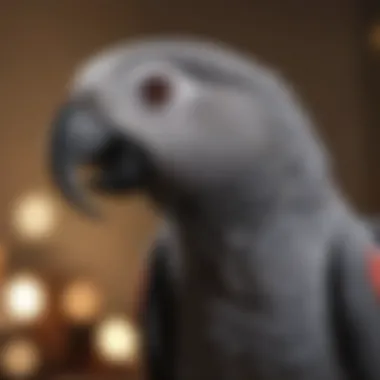
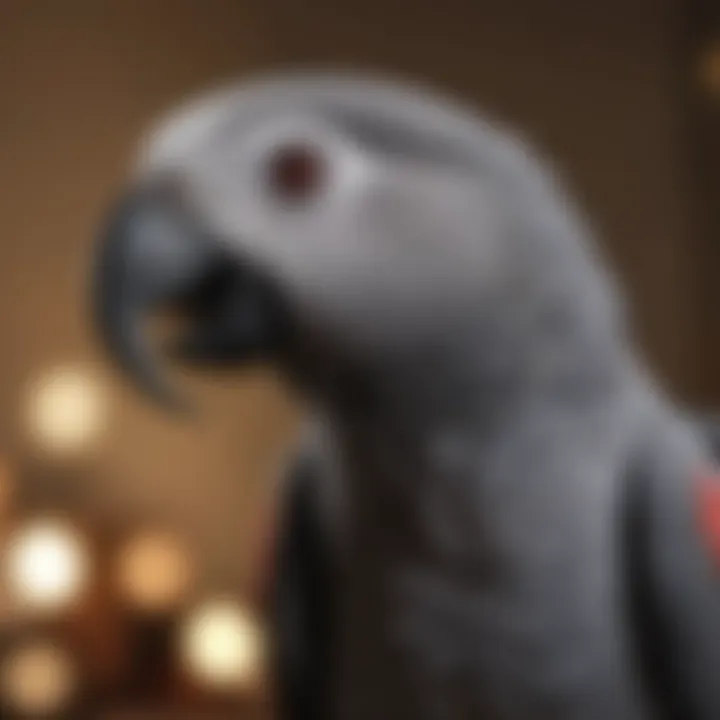
Vocalization Patterns
Vocalization patterns vary significantly among different bird species. Each species has unique sounds and frequencies that they use for communication. For instance, the African Grey Parrot is known for its varied and complex vocalizations that can mimic human speech quite closely. Birds often vocalize to signal their presence or communicate with flock members. Observing how and when a bird vocalizes can reveal a lot about its mood and social interactions.
- Types of Vocalizations: Birds may chirp, squawk, or produce whistles, each serving different purposes.
- Frequency of Calls: Some birds are more talkative than others, vocalizing frequently throughout the day.
- Contextual Usage: Birds will change their vocalizations based on their environment, indicating excitement, distress, or contentment.
These patterns are not just noise; they are essential components of a bird's interactions, influenced by breeding, upbringing, and environment.
Social Dynamics and Calling
Social dynamics play a critical role in how vocal birds interact. Birds are inherently social creatures, and their calls are a key part of how they establish and maintain social bonds. This is particularly true among species that live in flocks, like Amazon Parrots. Calls can indicate hierarchy, alert others to danger, or help coordinate group movements.
- Social Structure: Different vocalizations can signify roles within a flock, such as leaders or sentinels.
- Pair Bonding: Many vocal birds will engage in duet calls with their partners, reinforcing their bond.
- Learning from Others: Young birds often learn their vocalizations by mimicking older birds, showcasing the importance of social learning in vocal development.
Understanding these social dynamics helps owners interpret their birds' behaviors more accurately and respond appropriately.
Emotional Expression Through Sound
Birds express their emotions through sound, making vocalization a crucial aspect of their emotional well-being. Vocalization can indicate a variety of feelings, from happiness to stress. Watching how a bird vocalizes in relation to its environment can offer insights into its emotional state.
- Joyful Sounds: Happy birds may sing or whistle more, showing contentment.
- Distress Calls: Loud, frantic calls can signal fear or discomfort.
- Affectionate Chirping: Gentle chirps can highlight feelings of affection towards their owners or other birds.
In summary, observing these common behavioral traits of vocal birds empowers owners to create a nurturing environment that caters to their feathered companions' emotional and social needs. Understanding vocalization patterns, social dynamics, and emotional expressions leads to a more fulfilling relationship between birds and their owners.
Health Considerations for Vocal Birds
The health of vocal birds is pivotal in ensuring their ability to communicate and engage effectively. A variety of health considerations play a crucial role in maintaining not just the vocal capabilities of these pets but also their overall well-being. Understanding these elements equips pet owners with the knowledge needed to foster an environment conducive to their birds’ health and communication skills.
Impact of Stress on Vocalization
Stress can severely impact a bird's ability to vocalize effectively. Birds are sensitive creatures, and changes in their environment, such as loud noises, unfamiliar visitors, or even fluctuations in routine, can induce stress. When a bird is stressed, it may become quiet or even withdraw from vocal communication entirely. Understanding the sources of stress is key to providing a peaceful living situation. Common stressors include:
- Loud sounds from nearby construction or other pets.
- Changes in cage location or size.
- Lack of social interaction or handling.
- Illness or pain, which can generally affect behavior.
Minimizing these stressors is vital. Providing safe spaces, using calming products, and maintaining a consistent routine can help mitigate stress, thus promoting vocal behavior.
Connection Between Nutrition and Vocal Ability
Nutrition plays a critical role in a bird's ability to vocalize. Quality diets contribute to the overall health, affecting feather quality, energy levels, and vocal strength. Birds require a balanced diet comprising seeds, pellets, fruits, and vegetables. Each of these food types offers distinct benefits:
- Seeds: While often loved by birds, high seed diets should be balanced with other foods to avoid obesity.
- Pellets: These provide essential vitamins and minerals, optimizing health.
- Fruits and Vegetables: Fresh produce adds hydration and necessary nutrients that can directly influence vocal strength and clarity.
Proper hydration is also crucial; birds need access to clean, fresh water daily. Healthy birds typically exhibit more varied and expressive vocal patterns.
Regular Veterinary Check-Ups
Routine veterinary care forms the backbone of avian health management. Regular check-ups can help identify potential health issues early on, thereby preventing complications that may affect vocal abilities. Pet bird owners should ensure:
- Consistent visits to an avian veterinarian mentioned at reddit.com.
- Monitoring for signs of illness, such as changes in vocalization, eating habits, or behavior.
- Vaccinations and parasite control, based on the vet's recommendations.
Regular veterinary check-ups not only help keep potential vocal issues at bay but also contribute to a longer, healthier life for pet birds. Overall, maintaining good health through proper care will foster vocal proficiency and a social environment for communication.
Creating an Ideal Environment for Talking Birds
Creating an ideal environment for talking birds is crucial for fostering their natural communication abilities. A well-structured habitat not only supports the overall health of the bird but also enhances its chances of developing strong vocal skills. When discussing an environment conducive to avian communication, several specific elements warrant attention.
Cage Setup and Location
The cage serves as the primary habitat for pet birds, and its setup plays a significant role in their happiness and vocalization. A larger cage allows for more movement and exploration. Birds like African Grey Parrots and Macaws benefit greatly from spacious settings that accommodate climbing and playing. The location of the cage is also important.
- Visibility: Place the cage in a room where the bird can observe family activities. This reduces feelings of isolation and encourages vocalization, as birds often mimic sounds they hear frequently.
- Safety: Ensure the cage is away from direct sunlight and drafts. Extreme temperatures can affect a bird's health and its willingness to communicate.
- Accessibility: The cage door should be easily accessible for you and the bird. Regular interaction encourages trust and can prompt vocal behaviors.
Socialization Opportunities
Birds are inherently social creatures, and socialization significantly influences their ability to communicate. Making efforts to socialize your pet bird will enhance its vocal skills. Here are key considerations for promoting social interactions:
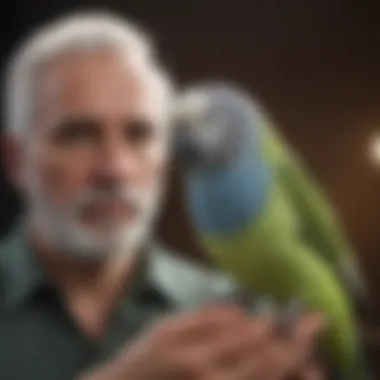
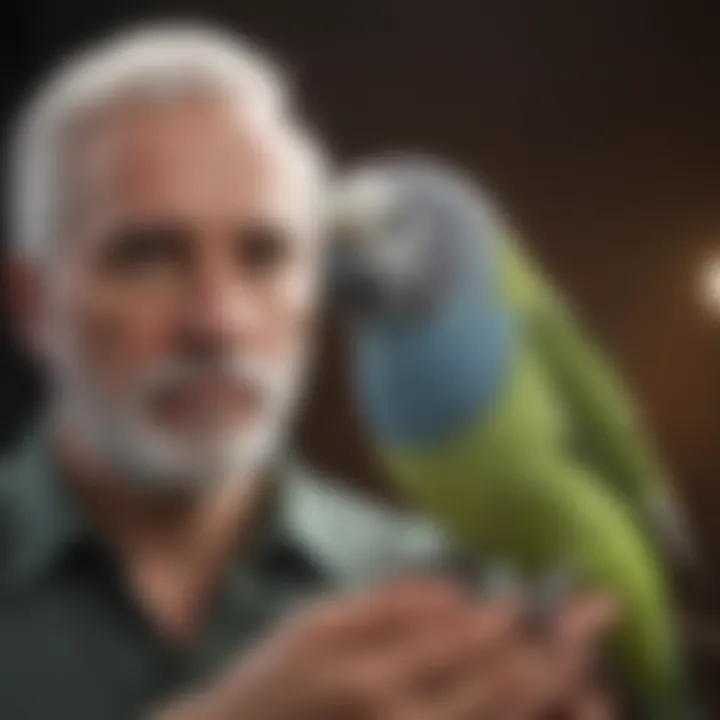
- Human Interaction: Spend time each day interacting with your bird. Speaking to it frequently in a calm voice encourages mimicry of those sounds.
- Flock Dynamics: If you have multiple birds, their interactions with one another can foster vocal development. Birds often learn from observing each other; sharing a space with vocal companions can stimulate their communication skills.
- Visitations: Introducing your bird to new people can expose it to varied sounds and words. This diversity can enhance the bird's vocabulary as it mimics those new voices.
Mental Stimulation and Toys
Providing mental stimulation is fundamental to keeping a talking bird engaged. Boredom can lead to less vocal activity. Thus, incorporating toys and activities is essential for encouraging communication:
- Variety of Toys: Use different types of toys, such as puzzle toys and foraging devices. These encourage play and may lead to sounds and vocalizations as the bird engages with the items.
- Routine Changes: Rotate toys regularly. Introducing new challenges keeps the environment interesting and stimulates exploration, which may result in increased vocal activity.
- Interactive Play: Engage in interactive sessions using toys that require participation from the bird. Activities that involve problem-solving can enhance both mental dexterity and vocalization.
Providing an enriching environment, with thoughtful cage setup and social opportunities, significantly contributes to a bird’s willingness to engage vocally.
In summary, creating an ideal environment for talking birds involves a comprehensive approach focusing on cage setup, opportunities for socialization, and the provision of mental stimulation through toys. Each of these factors contributes to enhancing the bird's ability and desire to communicate, supporting its health and well-being.
Common Myths About Talking Birds
Understanding common myths about talking birds is essential for both current and prospective bird owners. These misconceptions can lead to unrealistic expectations and can affect the way owners interact with their birds. Addressing these myths helps to foster better relationships between birds and their human companions. Additionally, knowing the facts allows owners to optimize their approach to training and care.
Are All Parrots Great Talkers?
It is a widespread belief that all parrot species possess exceptional vocal abilities. However, this is not accurate. While many parrots are renowned for their talking skills, such as African Grey Parrots and Amazon Parrots, not every species has the same capacity for mimicry. Some species, like the Cockatiel or the Lovebird, can produce limited vocalizations, primarily consisting of whistles or squawks, rather than complex speech. Understanding this difference is critical when choosing a pet bird. Owners should do precise research on the species that fits their expectations for vocal ability.
Do Birds Understand Human Language?
There is considerable debate about whether talking birds truly understand human language. Birds like the African Grey Parrot can mimic phrases and even respond in context. They associate certain sounds with specific outcomes. Yet, this does not equate to comprehension on the level of humans. Their interactions often reflect learned behaviors rather than a genuine understanding of language. Pet owners should appreciate their bird’s ability to mimic sounds as a fascinating skill, rather than an indication of linguistic understanding. This perspective helps shape more effective communication techniques between birds and their owners.
Talking Birds Will Always Talk
Another common myth is the notion that once a bird learns to talk, it will continue to do so consistently. In reality, various factors can influence a bird's inclination to vocalize. Changes in environment, stress, or health issues may lead to decreased vocalizations over time. Additionally, individual personality traits play a significant role. Some birds may be naturally more vocal while others prefer quiet. Owners should be aware that while many birds can learn to talk, their willingness to do so can fluctuate. This understanding emphasizes the need for consistent interaction and care, which fosters a communicative environment.
Understanding these myths is crucial for nurturing a positive relationship with your pet bird.
The Bond Between Owner and Bird
Understanding the bond between an owner and their bird is vital. This relationship significantly influences the bird's vocal abilities and overall well-being. Birds are social creatures and thrive on the interaction they receive from their human counterparts. A strong bond also enhances the owner's ability to effectively train their bird to engage in vocalization.
A healthy bond results in mutual trust, which opens avenues for communication. When a bird feels secure in its environment, it is more likely to vocalize. Encouraging interactions is essential for developing this relationship. This can include talking to the bird, sharing space, and allowing it to observe daily activities.
Enhancing Communication Through Interaction
Interaction is key to enhancing communication between an owner and a pet bird. Engaging with your bird regularly can improve its comfort level with human vocalizations. One effective way to do this is through consistent verbal engagement. Speak to your bird in a calm and encouraging tone. This encourages the bird to respond. Playtime is also significant. Using toys can stimulate a bird's curiosity and creativity. Adding elements like laughter or cheerful tones during playtime can prompt the bird to mimic these sounds.
In addition, introducing training sessions can significantly enhance communication. Use positive reinforcement techniques to encourage vocalizations. Gradually introduce new words or phrases. You can see how the bird starts to mimic what it hears. Remember, patience is a core component in this process.
Building Trust and Affection
Trust is the foundation of any positive relationship with a bird. Building this trust requires time and consistency. Start by allowing the bird to acclimate to your presence without pressure. Simple acts such as sitting nearby and letting it approach you when it feels comfortable can set a welcoming atmosphere. Routinely handling the bird can also foster trust. This should be done gently and with care to avoid startling it.
Affection often translates into trust. Birds respond positively to gentle handling and petting. Offering treats or rewards after engaging can be an effective way to build that bond. Establishing a daily routine also helps the bird feel secure in its environment. Consistency reassures the bird, making it more open to interaction.
Understanding the bond between an owner and a bird is not merely beneficial; it is essential for fostering a vibrant and communicative pet.
"A well-cared-for bird thrives in its environment and is willing to share its voice."
In summary, interaction and trust are crucial components in developing a strong relationship with a pet bird. An owner’s efforts to build this bond will significantly influence the bird’s social behavior and propensity for vocalization.
Epilogue
The discussion on effective training techniques emphasizes the importance of positive reinforcement and consistency in interactions. An informed bird owner can effectively foster an environment where their pet’s natural tendencies can flourish. Additionally, the understanding of health considerations and the creation of an ideal habitat play crucial roles in ensuring that a birds' vocal capabilities are nurtured. Responsible ownership extends beyond providing food and shelter; it encompasses the emotional and mental wellbeing of these sensitive creatures.
As we have navigated through the intricate topics of avian communication, it becomes clear that the benefits of a well-educated approach to owning talkative birds are significant, not only for the birds' health and happiness but also for enriching the owner's life through enhanced interaction and companionship. Reflecting on these elements lays the foundation for a fulfilling relationship with pet birds.
Summary of Key Points
- Vocalization as a Communication Tool: Birds use vocalization to express their needs and emotions. Learning about these patterns enhances interactions.
- Species Differences: Different bird species, like African Grey Parrots and Macaws, have unique traits influencing their mimicry abilities.
- Training Techniques: Effective methods include positive reinforcement and establishing a routine that empowers birds to learn and mimic speech more efficiently.
- Health Impact: The physical and emotional health of birds directly impacts their vocalization capabilities. Regular check-ups and a healthy diet are paramount.
- Creating an Environment: An optimal environment rich in stimulation and opportunities for socialization encourages vocal development.
Encouragement for Responsible Ownership
Bird ownership is a commitment that goes beyond enjoying their chatter. Prospective owners must consider the unique needs of their feathered companions. Here are a few important practices:
- Research: Learn about the specific species before bringing a bird home. Each species has distinct behavioral and social needs.
- Commitment: Birds often live for many years. Owners should be prepared for a long-term relationship requiring ongoing care and attention.
- Engagement: Regular interaction is vital for a birds' mental health. Spend quality time talking and playing with your bird.
- Education: Stay informed about avian care, training techniques, and dietary needs. Join communities or forums, such as those found on Reddit or Facebook, to gain insights from other bird owners.
- Veterinary Care: Prioritize regular veterinary visits to monitor health and address any issues promptly. A bird in good health is likely to be more vocal and engaged.
By embracing these principles, owners can ensure a mutually enriching relationship that celebrates the unique bond between humans and their talkative bird companions.















